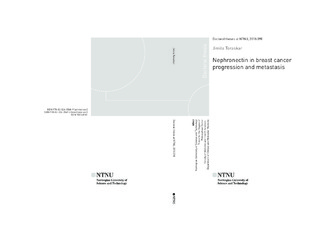| dc.contributor.advisor | Steigedal, Tonje S. | |
| dc.contributor.advisor | Bjørkøy, Geir | |
| dc.contributor.advisor | Lundgren, Steinar | |
| dc.contributor.advisor | Svineng, Gunbjørg | |
| dc.contributor.author | Toraskar, Jimita Prashant | |
| dc.date.accessioned | 2019-02-12T08:01:59Z | |
| dc.date.available | 2019-02-12T08:01:59Z | |
| dc.date.issued | 2018 | |
| dc.identifier.isbn | 978-82-326-3569-6 | |
| dc.identifier.issn | 1503-8181 | |
| dc.identifier.uri | http://hdl.handle.net/11250/2584907 | |
| dc.description.abstract | Breast cancer is life threatening due to its ability to spread and invade other tissues. The best approach in solving a problem of this sort is to be able to reason backwards. Tumors appear chaotic as they are composed of multiple abnormal cell types and a complex matrix of proteins that cushions the tumor cells extracellularly. In fact, some characteristics of tumor development resemble those seen in developing organs. Nephronectin (NPNT) is identified in several developing organs, but it is absent in normal healthy breast tissue. However for breast cancer progression and metastasis, NPNT appears to play a significant role, as elaborated in this thesis. Our results show that 596 out of 842 breast cancer cases stain positive for NPNT and the cytoplasmic granular staining pattern in less than 10% of the tumor cells correlates with poor prognosis. This granular staining pattern could indicate the involvement of vesicular communication. Extracellular vesicles derived from tumor cells facilitate intercellular communication both locally and systemically in the body. These vesicles are packed with oncogenic traits that can influence cancer progression, and metastasis. As per our investigation, NPNT is one the signaling molecules packed in the extracellular vesicles derived from breast cancer cells. Interestingly, the truncated form of NPNT was concentrated in these vesicles. We further show that the protein of small extracellular vesicles is altered upon NPNT expression in 66cl4 mouse breast cancer cells.
Breast cancer cells mainly spread to bones, liver, lungs and brain. It is challenging for the cancer cells to survive and adapt to a distant tissue microenvironment which is different compared to the primary tumor. In this thesis we highlight several oncogenic properties which are enhanced in presence of NPNT. We found that NPNT promotes viability, adhesion and anchorage-independent growth via its integrin-binding motifs. These oncogenic properties bestowed on tumor cells by NPNT enables them to colonize the lungs more efficiently. Different ligands can activate different intracellular signaling pathways, although binding to the same receptor. Therefore, it is important to investigate and document key signaling molecules triggered by different ligands in specific cell types. Our results indicate that NPNT induces phosphorylation of p38 MAPK via its enhancer motif to promote viability in 66cl4 cells. Therefore, we suggest that targeting both the enhancer and the RGD motif simultaneously would be more effective in rendering NPNT protein inactive. | nb_NO |
| dc.language.iso | eng | nb_NO |
| dc.publisher | NTNU | nb_NO |
| dc.relation.ispartofseries | Doctoral theses at NTNU;2018:390 | |
| dc.relation.haspart | Paper 1: Steigedal, Tonje S.; Toraskar, Jimita Prashant; Redvers, Richard P.; Valla, Marit; Magnussen, Synnøve; Bofin, Anna M.; Opdahl, Signe; Lundgren, Steinar; Eckhardt, Bedrich L.; Lamar, John Michael; Doherty, Judy; Hynes, Richard O.; Anderson, Robin L.; Svineng, Gunbjørg. Nephronectin is Correlated with Poor Prognosis in Breast Cancer and Promotes Metastasis via its Integrin-Binding Motifs. Neoplasia 2018 ;Volum 20.(4) s. 387-400
© 2018 The Authors. Published by Elsevier Inc. on behalf of Neoplasia Press, Inc.
This is an open access article under the CC BY-NC-ND license (http://
creativecommons.org/licenses/by-nc-nd/4.0/).
1476-5586
https://doi.org/10.1016/j.neo.2018.02.008 | |
| dc.relation.haspart | Paper 2:
Toraskar, Jimita Prashant; Magnussen, Synnøve; Chawla, Konika; Svineng, Gunbjørg; Steigedal, Tonje S..
Nephronectin mediates p38 MAPK‐induced cell viability via its integrin binding enhancer motif.
- Final version is published in FEBS Open Bio 2018 ;Volum 8. s. 1-10
© 2018 The Authors. Published by FEBS Press and John Wiley & Sons Ltd.
This is an open access article under the terms of the Creative Commons Attribution License Attribution 4.0 International (CC BY 4.0)
https://doi.org/10.1002/2211-5463.12544 | |
| dc.relation.haspart | Paper 3:
Toraskar, Jimita Prashant; Magnussen, Synnøve; Hagen, Lars; Sharma, Animesh; Hoang, Linh; Bjørkøy, Geir; Svineng, Gunbjørg; Steigedal, Tonje S..
A novel truncated form of Nephronectin is present in small extracellular vesicles isolated from 66cl4-cells.
- Final version is published in
Journal of Proteome Research 2019
ACS AuthorChoice - This is an open access article published under an ACS AuthorChoice License, which permits copying and redistribution of the article or any adaptations for non-commercial purposes
https://doi.org/10.1021/acs.jproteome.8b00859 | |
| dc.title | Nephronectin in breast cancer progression and metastasis | nb_NO |
| dc.type | Doctoral thesis | nb_NO |
| dc.subject.nsi | VDP::Medical disciplines: 700::Clinical medical disciplines: 750 | nb_NO |
